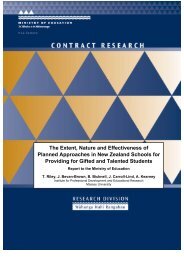GIFTED AND TALENTED STUDENTS: MEETING THEIR NEEDS IN NEW ZEALAND SCHOOLSSummary: Identifi cation of <strong>Gifted</strong> <strong>and</strong> <strong>Talented</strong> <strong>Students</strong>• Issues of equity are fundamental to the identification of the gifted <strong>and</strong> talented.An <strong>in</strong>clusive approach that will benefit as wide a group as possible is more valuablethan an exclusive approach.• Special attention should be given to the “hidden gifted”. These <strong>in</strong>clude thedisadvantaged gifted, the disabled gifted, those with learn<strong>in</strong>g difficulties, theunderachiev<strong>in</strong>g gifted, <strong>and</strong> those from m<strong>in</strong>ority cultural <strong>and</strong> ethnic groups.• Identification is a mediat<strong>in</strong>g l<strong>in</strong>k between def<strong>in</strong>itions of giftedness <strong>and</strong> talent <strong>and</strong>educational programmes.• It is helpful to have a school-wide policy on the gifted <strong>and</strong> talented that coord<strong>in</strong>atesidentification <strong>in</strong> the school.• Some of the pr<strong>in</strong>ciples of sound identification suggest that it should beg<strong>in</strong> early, becont<strong>in</strong>uous, <strong>in</strong>corporate a team approach, be as unobtrusive as possible, <strong>and</strong> <strong>in</strong>cludeboth quantitative <strong>and</strong> qualitative methods.• Identification should employ a wide range of quantitative <strong>and</strong> qualitative methods.Some of these methods are:– teacher, self-, peer, <strong>and</strong> parent nom<strong>in</strong>ation;– st<strong>and</strong>ardised tests of <strong>in</strong>telligence, achievement, <strong>and</strong> creativity;– teacher-made tests;– portfolios <strong>and</strong> performance-based assessments;– rat<strong>in</strong>g scales <strong>and</strong> checklists.• A responsive learn<strong>in</strong>g environment approach, <strong>in</strong> which rich <strong>and</strong> stimulat<strong>in</strong>g learn<strong>in</strong>gexperiences can take place, helps to challenge gifted <strong>and</strong> talented students <strong>and</strong> toenable their special abilities to “surface” <strong>and</strong> be identified. Such an approach isparticularly helpful for identify<strong>in</strong>g gifted <strong>and</strong> talented students who are disabled,disadvantaged, or from different cultural groups.• Identify<strong>in</strong>g gifted students from diverse cultures poses special challenges.St<strong>and</strong>ardised tests of <strong>in</strong>telligence <strong>and</strong> achievement <strong>and</strong> even teacher <strong>and</strong> selfnom<strong>in</strong>ationsare often not appropriate or effective. Of more value for identify<strong>in</strong>gMäori students <strong>and</strong> those from other ethnic groups are the evaluation of students’products, careful teacher observation through a responsive learn<strong>in</strong>g environment,<strong>and</strong> <strong>in</strong>put from whänau members <strong>and</strong> kaumätua.34
PART TWO: PROGRAMME DEVELOPMENT AND EVALUATIONPART 2: PROGRAMME DEVELOPMENT AND EVALUATIONDifferentiation for the <strong>Gifted</strong> <strong>and</strong> <strong>Talented</strong>: Pr<strong>in</strong>ciples <strong>and</strong> PracticesOnce gifted <strong>and</strong> talented students have been identified, our next question might well be “Nowwhat do we do with them?” While the options are many, the crucial factor <strong>in</strong> programmedevelopment <strong>and</strong> implementation is to make certa<strong>in</strong> that programmes are appropriate. Us<strong>in</strong>gidentification as a means to an end, as McAlp<strong>in</strong>e (1996) advocates, rather than an end <strong>in</strong>itself, helps ensure that the differentiated programme is tailored to the <strong>in</strong>dividual strengths<strong>and</strong> <strong>in</strong>terests of the gifted <strong>and</strong> talented.The purpose of def<strong>in</strong><strong>in</strong>g <strong>and</strong> identify<strong>in</strong>g giftedness is to uncover <strong>in</strong>dividual abilities, qualities,<strong>and</strong> <strong>in</strong>terests, <strong>and</strong> the objective of differentiation is to further develop them. <strong>Gifted</strong> education,<strong>in</strong> its simplest terms, is about enabl<strong>in</strong>g gifted <strong>and</strong> talented students to discover <strong>and</strong> followtheir passions. It’s about open<strong>in</strong>g doors, remov<strong>in</strong>g ceil<strong>in</strong>gs, <strong>and</strong> rais<strong>in</strong>g expectations byprovid<strong>in</strong>g an educational experience that strives towards excellence.A different way of learn<strong>in</strong>g is what kids are call<strong>in</strong>g for. All of them are talk<strong>in</strong>g about how ourone-size-fits-all delivery system – which m<strong>and</strong>ates that everyone learn the same th<strong>in</strong>g atthe same time, no matter what their <strong>in</strong>dividual learn<strong>in</strong>g needs – has failed them.(Sarason, 1993, cited <strong>in</strong> Toml<strong>in</strong>son, 1999, page 1)The <strong>New</strong> Zeal<strong>and</strong> Curriculum advocates flexibility <strong>and</strong> <strong>in</strong>clusion, but it is questionable whetherour classrooms adequately provide for the needs of gifted <strong>and</strong> talented students. The arrayof possibilities offered by differentiation may be used to enhance the educational experiencesof our gifted <strong>and</strong> talented students, creat<strong>in</strong>g classrooms tailored to <strong>in</strong>dividual size <strong>and</strong> fit.Pr<strong>in</strong>ciples of Differentiation for All <strong>Students</strong>1. The teacher is clear about what matters <strong>in</strong> subject matter.2. The teacher underst<strong>and</strong>s, appreciates, <strong>and</strong> builds upon student differences.3. Assessment <strong>and</strong> <strong>in</strong>struction are <strong>in</strong>separable.4. The teacher adjusts content, process, <strong>and</strong> product <strong>in</strong> response to student read<strong>in</strong>ess,<strong>in</strong>terests, <strong>and</strong> learn<strong>in</strong>g profile.5. All students participate <strong>in</strong> respectful work.6. <strong>Students</strong> <strong>and</strong> teachers collaborate <strong>in</strong> learn<strong>in</strong>g.7. Goals of a differentiated classroom are maximum growth <strong>and</strong> <strong>in</strong>dividual success.8. Flexibility is the hallmark of a differentiated classroom.(Toml<strong>in</strong>son, 1999, page 48)Ideally, these pr<strong>in</strong>ciples provide a framework for all <strong>New</strong> Zeal<strong>and</strong> classrooms <strong>and</strong> for allstudents. Yet to avoid fall<strong>in</strong>g <strong>in</strong>to a one-size-fits-all pattern of differentiation, it is importantto look at how to make this happen for gifted <strong>and</strong> talented students.35
- Page 1 and 2: Gifted and Talented StudentsMeeting
- Page 3 and 4: GIFTED AND TALENTED STUDENTS: MEETI
- Page 5 and 6: ForewordGifted and Talented Student
- Page 7 and 8: INTRODUCTIONNew Zealand teachers ar
- Page 9 and 10: GETTING STARTEDMany schools have di
- Page 11 and 12: GETTING STARTEDtheir skills should
- Page 13 and 14: PART ONE: DEFINITIONS, CHARACTERIST
- Page 15 and 16: PART ONE: DEFINITIONS, CHARACTERIST
- Page 17 and 18: PART ONE: DEFINITIONS, CHARACTERIST
- Page 19 and 20: PART ONE: DEFINITIONS, CHARACTERIST
- Page 21 and 22: PART ONE: DEFINITIONS, CHARACTERIST
- Page 23 and 24: PART ONE: DEFINITIONS, CHARACTERIST
- Page 25 and 26: PART ONE: DEFINITIONS, CHARACTERIST
- Page 27 and 28: PART ONE: DEFINITIONS, CHARACTERIST
- Page 29 and 30: PART ONE: DEFINITIONS, CHARACTERIST
- Page 31 and 32: PART ONE: DEFINITIONS, CHARACTERIST
- Page 33: PART ONE: DEFINITIONS, CHARACTERIST
- Page 37 and 38: PART TWO: PROGRAMME DEVELOPMENT AND
- Page 39 and 40: PART TWO: PROGRAMME DEVELOPMENT AND
- Page 41 and 42: PART TWO: PROGRAMME DEVELOPMENT AND
- Page 43 and 44: PART TWO: PROGRAMME DEVELOPMENT AND
- Page 45 and 46: PART TWO: PROGRAMME DEVELOPMENT AND
- Page 47 and 48: PART TWO: PROGRAMME DEVELOPMENT AND
- Page 49 and 50: PART TWO: PROGRAMME DEVELOPMENT AND
- Page 51 and 52: PART TWO: PROGRAMME DEVELOPMENT AND
- Page 53 and 54: PART TWO: PROGRAMME DEVELOPMENT AND
- Page 55 and 56: PART TWO: PROGRAMME DEVELOPMENT AND
- Page 57 and 58: PART TWO: PROGRAMME DEVELOPMENT AND
- Page 59 and 60: RECOMMENDED READINGSRecommended Rea
- Page 61 and 62: REFERENCESAdditional Recommended Re
- Page 63 and 64: REFERENCESHigh Ability StudiesThe o
- Page 65 and 66: REFERENCESKrathwohl, D. R., Bloom,
















